

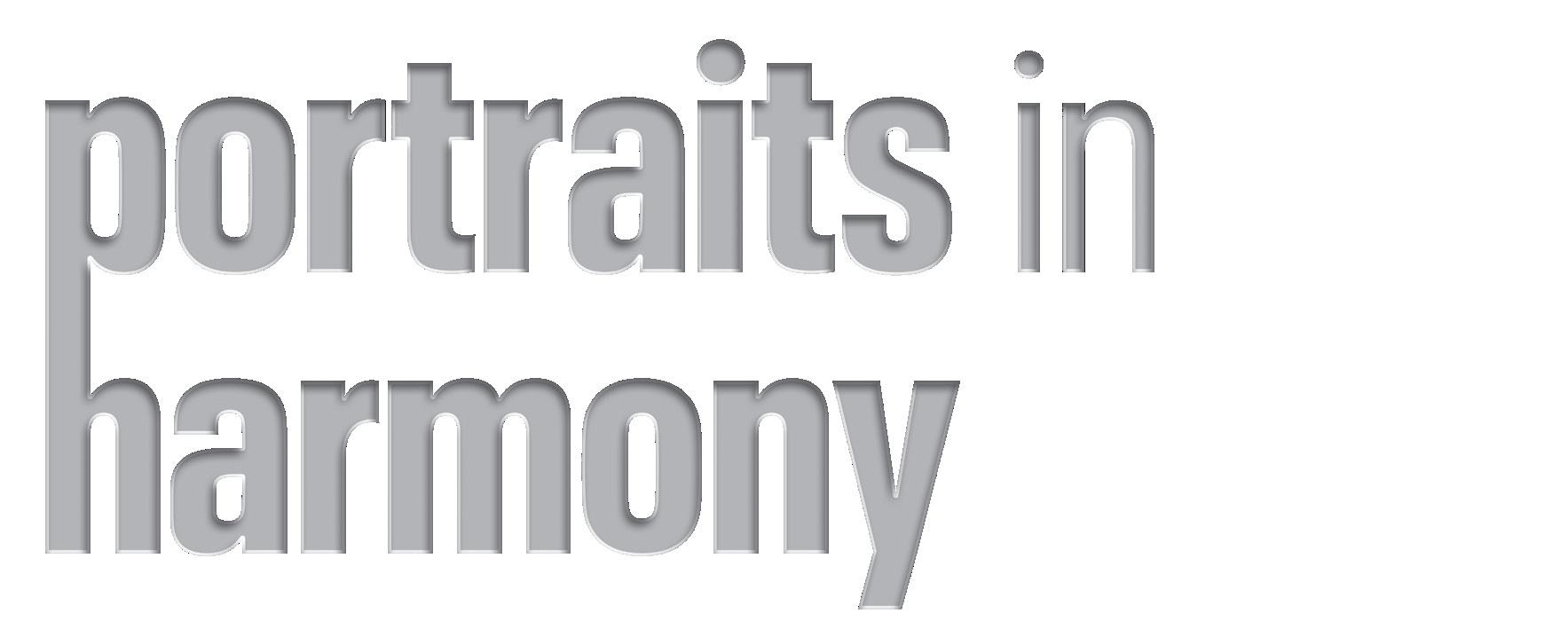
The 2022–23 Civic Orchestra season is generously sponsored by The Julian Family Foundation, which also provides major funding for the Civic Fellowship program.
2 ONE HUNDRED FOURTH SEASON
HUNDRED THIRD
CIVIC ORCHESTRA OF CHICAGO
Ken-David Masur Principal Conductor
The Robert Kohl and Clark Pellett Principal Conductor Chair
Monday, October 17, 2022, at 8:00
Ken-David Masur Conductor
r. strauss Till Eulenspiegel’s Merry Pranks, Op. 28
alberga Tower
Dylan Marshall Feldpausch Violin
Marian Antonette Mayuga Violin
Teddy Schenkman Viola Lindsey Sharpe Cello intermission
brahms Symphony No. 3 in F Major, Op. 90
Allegro con brio
Andante
Poco allegretto
Allegro
The 2022–23 Civic Orchestra season is generously sponsored by The Julian Family Foundation, which also provides major funding for the Civic Fellowship program. This program is partially supported by a grant from the Illinois Arts Council Agency.
CSO.ORG/INSTITUTE 3 ONE
SEASON
comments by phillip huscher | richard e. rodda
richard strauss
Born June 11, 1864; Munich, Germany
Died September 8, 1949; Garmisch, Germany
Till Eulenspiegel’s Merry Pranks, Op. 28
Had Strauss’s first opera, Guntram, succeeded as he hoped, he surely would have gone ahead with his plan to make Till Eulenspiegel’s Merry Pranks his second. But Guntram was a major disappointment and Strauss reconsidered. We’ll never know what sort of opera Till Eulenspiegel might have been—the unfinished libretto isn’t promising—but as a tone poem it’s close to perfection.
The failure of Guntram hurt—Strauss wasn’t used to bad reviews or public indifference. Now, more than ever, he refused to give up on his hero, Till Eulenspiegel, an incorrigible prank ster with a certain contempt for humanity, who sets out to get even with society. (There was a real Till Eulenspiegel who lived in the fourteenth century.) But Strauss was no longer certain that the opera stage was the best place to tell this story—“the figure of Master Till Eulenspiegel does not quite appear before my eyes,” he finally confessed—and he returned to the vehicle of his greatest past successes, the orchestral tone poem. Till Eulenspiegel’s Merry Pranks is arguably his greatest achieve ment in the form.
Ferruccio Busoni once said that in Till Eulenspiegel Strauss reached a mastery of lightness and humor unrivaled in German music since Haydn. The humor wasn’t so surprising—although some listeners had found the deep seriousness of Death and Transfiguration, Strauss’s previous tone poem, worrisome—but to achieve such transparency with an orchestra of unparalleled size seemed miraculous.
At the time of the premiere of Till Eulenspiegel, Strauss resisted fitting a narrative to his music, but he later admitted a few points of reference. He begins by beckoning us to gather round, setting a warm “once-upon-a-time” mood into which the horn jumps with one of the most famous themes in all music—the daring, teasing, cartwheeling tune that character izes this roguish hero better than any well-chosen words ever could. The portrait is rounded off by the nose-thumbing pranks of the clarinet.
From there the music simply explodes, as the orchestra responds to Till’s every move. When he dons the frock of a
composed 1894–95
first performance November 5, 1895; Cologne, Germany instrumentation three flutes and piccolo, three oboes and english horn, two clarinets, clarinet in D and bass clarinet, three bassoons and contrabassoon, four horns, three trumpets, three trombones, tuba, timpani, snare drum, bass drum, cymbals, triangle, large rattle, strings
approximate performance time 16 minutes
above: Richard Strauss, portrait by Edward Steichen (1879–1973), New York, 1904

4 ONE HUNDRED FOURTH SEASON
priest, the music turns mock-serious; when he escapes, down a handy violin glissando, in search of love, Strauss supplies sumptuous string har monies Don Juan would envy. Rejected in love, Till takes on academia, but his cavalier remarks and the professors’ ponderous deliberations (intoned by the bassoons and bass clarinet) find no common ground. Till departs with a Grosse Grimasse (Strauss’s term) that rattles the entire orchestra, and then slips out the back way, whis tling as he goes.
After a quick review of recent escapades—a recapitulation of sorts—Till is brought before a
jury (the pounding of the gavel is provided by the fff roll of the side drum). The judge’s repeated pronouncements do not quiet Till’s insolent remarks. But the death sentence—announced by the brass, falling the interval of a major seventh, the widest possible drop short of an octave— silences him for good. It’s over in a flash.
Then Strauss turns the page, draws us round him once again, and reminds us that this is only a tone poem. And with a smile, he closes the book.
—Phillip Huscher
eleanor alberga
Born September 30, 1949; Kingston, Jamaica
Tower for String Quartet and Orchestra
British composer Eleanor Alberga was born in Kingston, Jamaica, in 1949, and announced at the age of five that she was going to be a concert pianist. She started composing works for piano soon thereaf ter. Alberga studied at the Jamaica School of Music, and in 1968 won the biennial Royal Schools of Music Scholarship for the West Indies, which allowed her to study piano and voice at the Royal Academy of Music in London beginning in 1970.
After graduating from the Royal Academy of Music, she began her career as a solo pianist, and was one of three final ists in the 1974 International Piano Concerto Competition in Dudley, England. Her other performance credits include the African dance company Fontomfrom, guitarist and vocalist with the Jamaican Folk Singers, and the duo Double Exposure with her husband, violinist Thomas Bowes; together they also founded Arcadia, an original festival in the English countryside where they live.
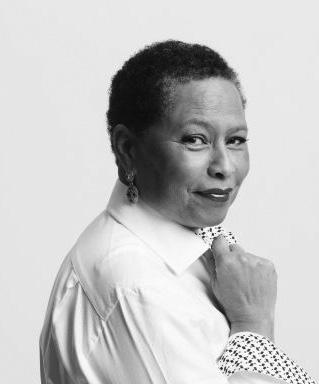
Alberga continued her dual career as pianist and composer until 2001, when she won a fellowship from the National Endowment for Science, Technology, and the Arts (NESTA) that allowed her to devote herself principally to composi tion. She has since become one of Britain’s most acclaimed
composed 2017 first performance October 27, 2017, at St. John the Evangelist Church, London; London Mozart Players and Maggini Quartet, Hilary Davan Wetton conducting
instrumentation two flutes and piccolo, two oboes, two clarinets, two bassoons, two horns, two trumpets, timpani, percussion, strings, and string quartet approximate performance time 11 minutes
above: Eleanor Alberga
CSO.ORG/INSTITUTE 5 COMMENTS
composers, with works for orchestra, chamber ensembles, voice, stage, and screen that have been performed and commissioned by such nota ble entities as the BBC Proms—the broadcast of her choral work Arise, Athena!, written for the Last Night of the 2015 Proms, was heard by mil lions and spread her reputation internationally— and Royal Opera, Covent Garden, where Letters of a Love Betrayed premiered in 2009. In addi tion to the NESTA Fellowship, Alberga’s honors include a Paul Hamlyn Award in 2019, election as a Fellow of the Royal Academy of Music in 2020, and inclusion in the Queen’s Birthday Honors in 2021 as an OBE for her services to British Music.
Eleanor Alberga on Tower
Tower was commissioned in 2017 for the London Mozart Players and Maggini Quartet in memory of David Angel, a consummate musician, hilarious companion, and much-missed friend. He became my first real friend in this country when we met shortly after
my arrival from Jamaica at the Royal Academy of Music, where we were students together. David was an endless encourager and enabler to so many people, not least myself, and one perspective of this work’s title is David being a tower of strength to so many. The orchestration is for string quartet and chamber orchestra, and includes a solo for the second violin in honor of David, who was violinist in my first serious chamber group, a piano trio.
There is no program as such in Tower. The piece lasts roughly ten minutes. The string quartet starts and is soon joined by the orches tra, building quickly. There follow episodes of slow and fast music, and the work ends with a flourish at the work’s most lively tempo. There is some significant use of David’s initials, repre sented by the notes D, E, and A, but these need not trouble the listener in any essential way. More, I have tried to summon a piece worthy of this fine man.
—Richard E. Rodda
johannes brahms
Born May 7, 1833; Hamburg, Germany Died April 3, 1897; Vienna, Austria
Symphony No. 3 in F Major, Op. 90
The Chicago Symphony Orchestra played Brahms’s Third Symphony in its very first season. By then, Johannes Brahms, still very much alive, had stopped writing symphonic music. It was a time of tying up loose ends, finishing business, and clearing the desk. (At the end of that season, in the spring of 1892, Theodore Thomas, the Orchestra’s first music director, invited Brahms to come to Chicago for the upcoming World’s Columbian Exposition, but the composer declined, saying he didn’t want to make the long trip.) It’s hard today to imagine that Brahms’s Third Symphony was once a challenging work of contemporary music. Yet several hundred people walked out of
composed 1882–83
first performance December 2, 1883; Vienna, Austria
instrumentation
two flutes, two oboes, two clarinets, two bassoons and contrabassoon, four horns, two trumpets, three trombones, timpani, strings
approximate performance time 40 minutes
left: Johannes Brahms, ca. 1880, chalk drawing by Olga von Miller zu Aichholz (1853–1931)
opposite page: Pastel drawing of pianist and composer Clara Schumann (1819–1896), 1878–79, by Franz von Lenbach (1836–1904)
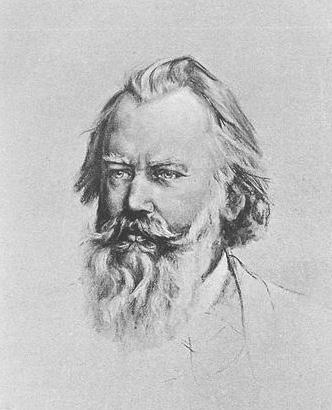
6 ONE HUNDRED FOURTH SEASON COMMENTS
the first Boston Symphony Orchestra performance in 1884, and the critic for the Boston Gazette called it “painfully dry, deliberate, and ungenial.” (It had been introduced to America a month before at one of Frank van der Stucken’s Novelty Concerts in New York.)
Even when Brahms’s music was new, it was hardly radical. Brahms was concerned with writing music worthy of stand ing next to that by Beethoven; it was this fear that kept him from placing the double bar at the end of his First Symphony for twenty years. Hugo Wolf, the adventuresome song com poser, said, “Brahms writes symphonies regard less of what has happened in the meantime.” He didn’t mean that as a compliment, but it touches on an important truth: Brahms was the first composer to develop successfully Beethoven’s rigorous brand of symphonic thinking.
Hans Richter, a musician of considerable perception, called this F major symphony Brahms’s Eroica. There’s certainly something Beethovenesque about the way the music is developed from the most compact material, although the parallel with the monumental, expansive Eroica is puzzling, aside from the opening tempo (Allegro con brio) and the fact that they are both third symphonies. Brahms’s Third Symphony is his shortest and his most tightly knit. Its substance came to him in a relatively sudden spurt: it was mostly written in less than four months—a flash of inspiration compared to the twenty years he spent on his First Symphony. Brahms was enjoying a trip to the Rhine at the time, and he quickly rented a place in Wiesbaden, where he could work in peace, and canceled his plans to summer in Bad Ischl. The whole F major symphony was written nonstop.
The benefit of such compressed work is a thematic coherence and organic unity rare even in Brahms. Clara Schumann wrote to Brahms on
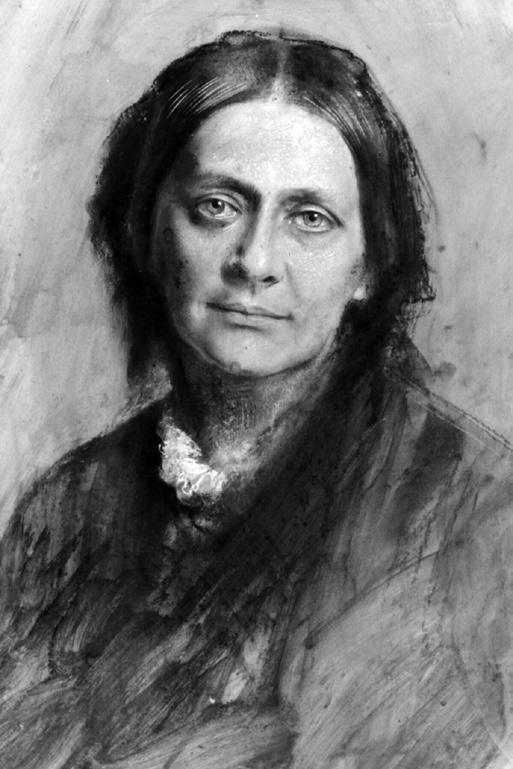
February 11, 1884, after having spent hours playing through the work in its two-piano ver sion: “All the movements seem to be of one piece, one beat of the heart.” Clara had been following Brahms’s career ever since the day he showed up at the door some thirty years ear lier, asking to meet her famous husband Robert. By 1884, Robert Schumann—Brahms’s first staunch advocate—was long dead, and Brahms’s on-again-off-again infatuation with Clara was off for good. But she was still a dear friend, a musician of great insight, and a keen judge of his work.
Surely, in trying to get her hands around the three massive chords with which Brahms begins, Clara noted in the top voice the rising F, A-flat, F motive that had become Brahms’s monogram for “frei aber froh” (free but joyful), an optimistic response to the motto of his friend Joseph Joachim, “frei aber einsam” (free but lonely). It’s one of the few times in Brahms’s music that the notes mean something beyond themselves. That particular motive can be pointed out again and again throughout the symphony—it’s the bass line for the violin melody that follows in measures three and four, for example. Clara also can’t have missed the continual shifting back and forth from A-natural to A-flat, starting with the first three chords and again in the very first phrase of Brahms’s cascading violin melody. Since the half step from A-natural down to A-flat darkens F major into F minor, the preeminence of F major isn’t so cer tain in this music, even though we already know from the title that it will win in the end.
In four measures (and as many seconds), Brahms has laid his cards on the table. In the course of this movement and those that fol low, we could trace, with growing fascination, the progress of that rising three-note motive,
CSO.ORG/INSTITUTE 7 COMMENTS
or the falling thirds of the violin theme, or the quicksilver shifts of major to minor that give this music its peculiar character. This is what Clara meant when she commented that “all the movements seem to be of one piece,” for, although Brahms’s connections are intricate and subtle, we sense their presence throughout.
For all its apparent beauty, Brahms’s Third Symphony hasn’t always been the most easily grasped of his works. Brahms doesn’t shake us by the shoulders as Beethoven so often did, even though the quality of his material and the logic of its development is up to the Beethovenian standards he set for himself. All four movements end quietly—try to name one other symphony of which that can be said—and some of its most powerful moments are so restrained that the tension is nearly unbearable.
Both the second and third movements hold back as much as they reveal. For long stretches, Brahms writes music that never rises above piano; when it does, the effect is always telling. The Andante abounds in beautiful writing for the clarinet, long one of Brahms’s favorite instru ments. (The year the Chicago Symphony first played this symphony, Brahms met the clarinet ist Richard Mühlfeld, who inspired the compos er’s last great instrumental works, the Clarinet Trio and the Clarinet Quintet.) The third move ment opens with a wonderful arching theme for cello—another of the low, rich sounds Brahms favored—later taken up by the solo horn in a pas sage so fragile and transparent it overrules all the textbook comments about the excessive weight of Brahms’s writing.
There is weight and power in the finale, although it begins furtively in the shadows
and evaporates into thin air some ten minutes later. The body of the movement is dramatic, forceful, and brilliantly designed. As the critic Donald Tovey writes in his famous essay on this symphony, “It needs either a close analysis or none at all.”
The latter will save the sort of scru tiny that’s not possible in the concert hall, but two things do merit men tion. The somber music in the trom bones and bassoons very near the beginning is a theme from the middle of the third movement (precisely the sort of thematic reference we don’t associate with Brahms). And the choice of F minor for the key of this movement was deter mined as early as the fourth bar of the symphony, when the cloud of the minor mode crossed over the bold F major opening. Throughout the finale, the clouds return repeatedly (and often unex pectedly), and Brahms makes something of a cliffhanger out of the struggle between major and minor. The ending is a surprise, not because it settles comfortably into F major, but because, in a way that’s virtually unknown to the sym phony before the twentieth century, it allows the music to unwind, all its energy spent, content with the memory of the symphony’s opening.
—Phillip Huscher
Phillip Huscher is the program annotator for the Chicago Symphony Orchestra.
Richard E. Rodda, a former faculty member at Case Western Reserve University and the Cleveland Institute of Music, provides program notes for many American orchestras, concert series, and festivals.
above: Clarinetist Richard Mühlfeld (1856–1907), a member of the Meiningen Court Orchestra and the inspiration for Brahms’s last instrumental works
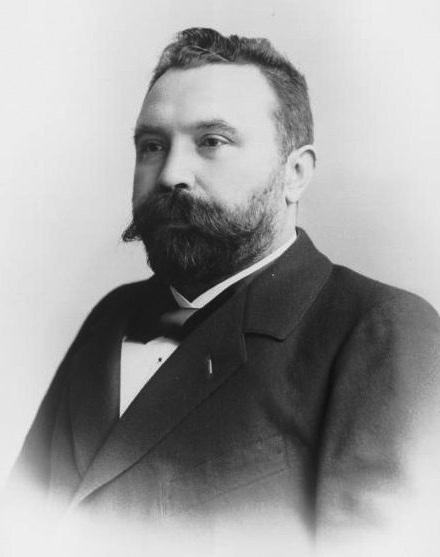
8 ONE HUNDRED FOURTH SEASON COMMENTS
negaunee music institute at the cso

Across Chicago and around the world, the Negaunee Music Institute connects people to the extraordinary musical resources of the Chicago Symphony Orchestra. Built on the Orchestra’s rich history of education and community engagement programming that began over a century ago, the NMI works to sustain the legacy of the CSO while helping to develop new and innovative programming. Reaching hundreds of thousands of people annually, NMI programs provide broad access to the CSO, educate young listeners, train young musicians, and serve the city and the world through music. All concerts and events seek to diversify the Chicago Symphony Orchestra Association’s audience and dissolve barriers to participation by being offered to the public free of charge or at a nominal fee.

Visit cso.org/institute to learn about the CSO's educational and community engagement programs and view details of the 2022–23 series of concerts and events.
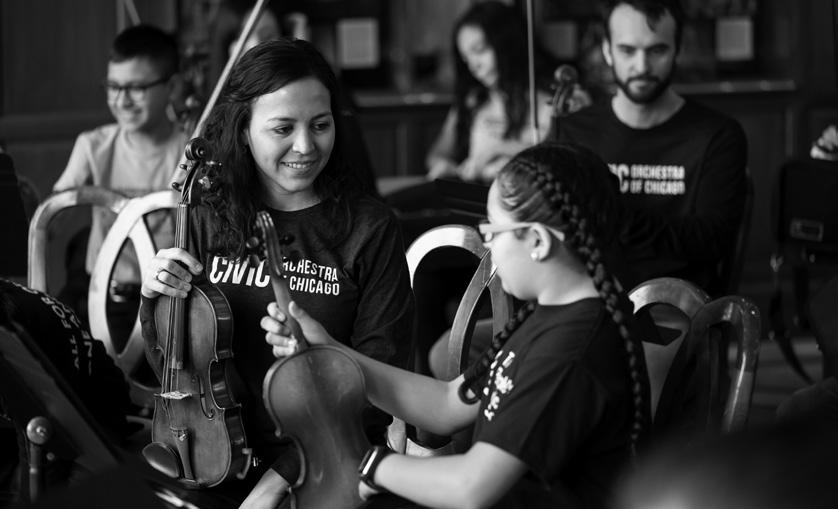
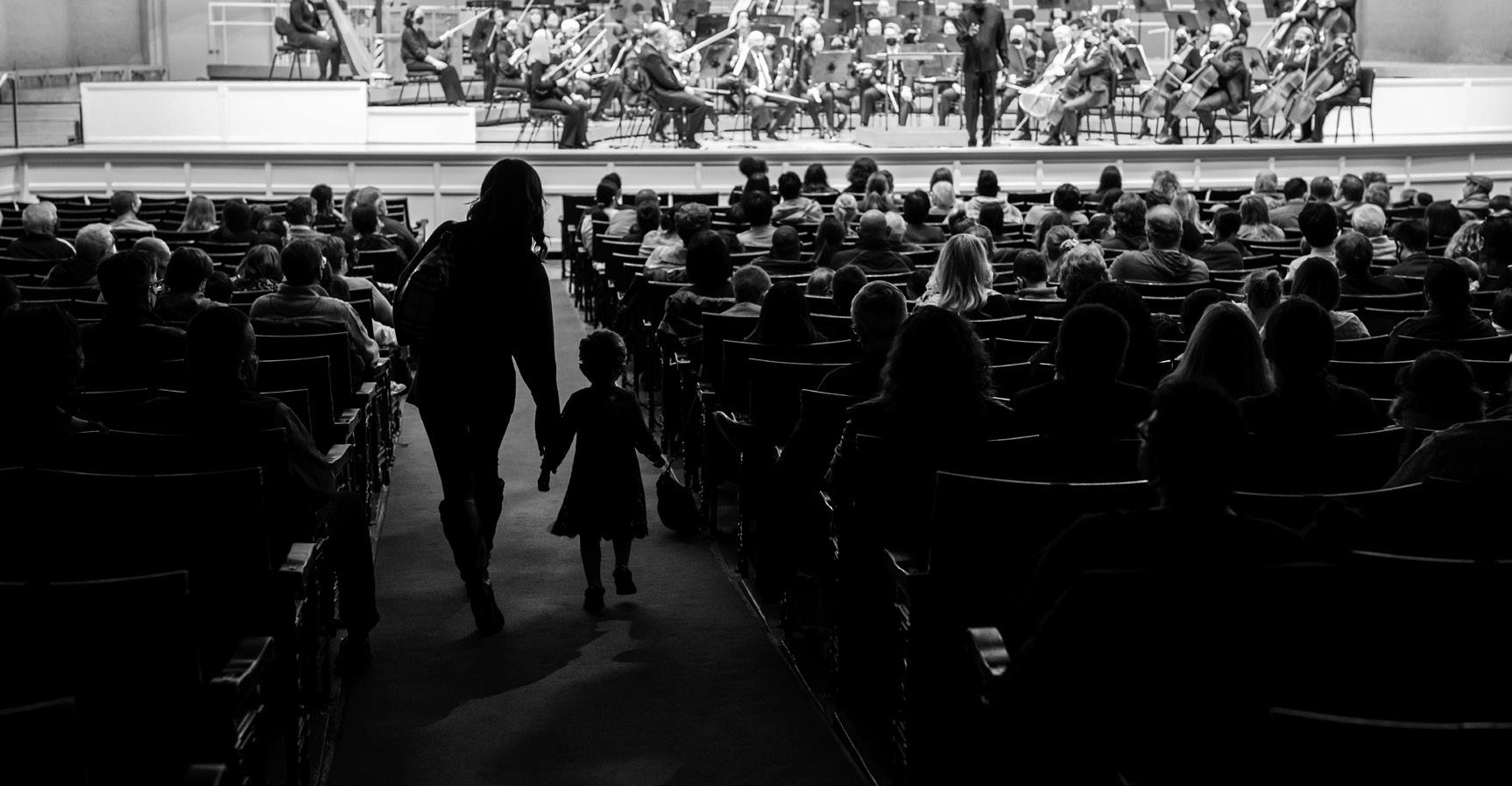
CSO.ORG/INSTITUTE 9
PHOTOS BY TODD ROSENBERG
profiles Ken-David Masur Conductor
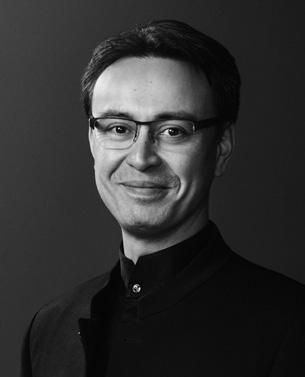
During the 2022–23 season, Masur leads a range of programs with the Milwaukee Symphony Orchestra, where his programming explores the natural world and its relationship to humanity. He also continues the second year of an MSO artistic partnership with pianist Aaron Diehl, and leads choral and symphonic works including Mendelssohn’s Elijah and Mahler’s Symphony no. 2. With the Civic Orchestra of Chicago, Masur leads concerts throughout the season, including the annual Bach Marathon in December 2022. Other engagements include subscription weeks with the Nashville and Omaha symphony orchestras, and a return to Poland’s Wroclaw Philharmonic.
In the summer of 2022, Masur debuted at the Pacific Music Festival in Sapporo, Japan, lead ing three programs with the Festival Orchestra, including members of the Berlin and Vienna philharmonics, and another concert with the Sapporo Symphony. He debuted at Classical Tahoe in three programs that were broadcast on PBS and led the Boston Symphony Orchestra with soloists Yo-Yo Ma, Itzhak Perlman, Branford Marsalis, and James Taylor at Tanglewood in a celebration of the composer John Williams.
Masur has conducted distinguished orches tras around the world, including the Chicago Symphony Orchestra, the Los Angeles Philharmonic, Orchestre National de France, the Yomiuri Nippon Symphony, the Orchestre National du Capitole de Toulouse, the National Philharmonic of Russia, and other orchestras
throughout the United States, France, Germany, Korea, Japan, and Scandinavia. Previously Masur was associate conductor of the Boston Symphony Orchestra, where he led numerous concerts, at Symphony Hall and at Tanglewood, of new and standard works featuring guest artists such as Renée Fleming, Dawn Upshaw, Emanuel Ax, Garrick Ohlsson, Joshua Bell, Louis Lortie, Kirill Gerstein, Nikolaj Lugansky, and others. For eight years, Masur served as prin cipal guest conductor of the Munich Symphony, and also as associate conductor of the San Diego Symphony and resident conductor of the San Antonio Symphony.
Music education and working with the next generation of young artists are of major impor tance to Masur. In addition to his work with the Civic Orchestra of Chicago, he has led orches tras and master classes at Tokyo Bunka Kaikan Chamber Orchestra, University of Wisconsin–Milwaukee’s Peck School of the Arts, New England Conservatory, Boston University, Boston Conservatory, the Tanglewood Music Center Orchestra, and at other leading universi ties and conservatories throughout the world.
Masur is passionate about the growth, encouragement, and application of contem porary music. He has conducted and com missioned dozens of new works, many of which have premiered at the Chelsea Music Festival, an annual summer music festival in New York City founded and directed by Masur and his wife, pianist Melinda Lee Masur. The festival seeks to engage audiences with its groundbreaking collaborations between the performing, visual, and culinary arts.
Ken-David Masur holds the Robert Kohl and Clark Pellett Principal Conductor Chair with the Civic Orchestra of Chicago.
10 ONE HUNDRED FOURTH SEASON
PHOTO BY ADAM DETOUR
Civic Orchestra of Chicago
Founded in 1919 by Frederick Stock, second music director of the Chicago Symphony Orchestra (CSO), the Civic Orchestra of Chicago prepares emerging professional musicians for lives in music. Civic members participate in rigorous orchestral training, September through June each season, with the Robert Kohl and Clark Pellett Principal Conductor Ken-David Masur, musicians of the CSO, and some of today’s most luminary conductors including the CSO’s Zell Music Director Riccardo Muti.
The importance of the Civic Orchestra’s role in Greater Chicago is underscored by its com mitment to present concerts of the highest qual ity at no charge to the public. In addition to the critically acclaimed live concerts at Symphony Center, Civic Orchestra performances can be heard locally on WFMT (98.7 FM).
Civic musicians also expand their creative, professional, and artistic boundaries and reach diverse audiences through educational perfor mances at Chicago Public Schools and a series of chamber concerts at various locations through out the city, including Chicago Park District field houses and the National Museum of Mexican Art.
To further expand its musician training, the Civic Orchestra launched the Civic Fellowship program in the 2013–14 season. Each year ten to
fifteen Civic members are designated as Civic Fellows and participate in intensive leadership training that is designed to build and diversify their creative and professional skills.
From 2010 to 2019, Yo-Yo Ma was a lead ing mentor to Civic musicians and staff in his role as CSO Judson and Joyce Green Creative Consultant, and the programs and initiatives he established are integral to the Civic Orchestra curriculum today. Civic Orchestra musicians develop as exceptional orchestral players and engaged artists, cultivating their ability to suc ceed in the rapidly evolving world of music in the twenty-first century.
The Civic Orchestra’s long history of present ing full orchestra performances free to the public includes annual concerts at the South Shore Cultural Center (in partnership with the South Shore Advisory Council) as well as numerous Chicago Public Schools. The Civic Orchestra is a signature program of the Negaunee Music Institute at the Chicago Symphony Orchestra, which offers a wide range of education and community programs that engage more than 200,000 people of diverse ages, incomes, and backgrounds each year, in Chicago and around the world.
For more on the Civic Orchestra of Chicago and its Principal Conductor Ken-David Masur, please visit cso.org/civic.
CSO.ORG/INSTITUTE 11 PROFILES
Civic Orchestra of Chicago Ken-David Masur Principal Conductor
The Robert Kohl and Clark Pellett Principal Conductor Chair
violins
Dylan Marshall Feldpausch*§ Subin Shin Gabriela Lara
Hee Woo Seo Shin Lan Annie Pham
Yu-Kun Hsiang Jonah Kartman
Crystal Qi Kristian Brusubardis Sungjoo Kang Liya Ma Jesus Linarez Tabitha Oh+ Robbie Herbst Hee Yeon Kim*
Marian Antonette Mayuga*§ Nelson Mendoza Hernandez* Laura Schafer Valentina Guillen Menesello Diane Yang* Kimberly Bill Ran Huo Matthew Weinberg Luke Lentini+ Grace Walker Kina Ono Emily Nardo Diego Diaz+ Kenichi Kiyama violas
Teddy Schenkman*§ Larissa Mapua Amanda Kellman Megan Yeung Kunjing Dai Cordelia Brand Stephanie Block Aditi Prakash Siyang Calvin Dai Bethany Pereboom+ Derrick Ware Benjamin Wagner+
cellos
Lindsey Sharpe*§ Abby Monroe
Francisco Malespin* Haley Slaugh Charlotte Ullman Annamarie Wellems Miles Link Lidanys Graterol Jaime An Hana Takemoto
basses
Ben Foerster Olivia Reyes Nathan Beaver Bennet Norris Hannah Novak Victor Stahoviak Leo Finan Matthew Daily flutes
Aalia Hanif Katarina Ignatovich Eric Leise+ Alyssa Primeau
oboes
James Jihyun Kim Andrew Port* Oliver Talukder Guillermo Ulloa
clarinets
Irina Chang Antonio Garrasi Joseph Sanchez+ Daniel Solowey
bassoons
Mackenzie Brauns* Liam Jackson Tsz-Ho Liu Seo Young (Michelle) Min
horns Sylvia Denecke
Asuncion Martínez
Jacob Medina Michael Stevens Ryan Williamson
trumpets
Ismael Cañizares Ortega
Joshua Harris
Isaac Hopkins Michael Leavens
trombones
Felix Regalado Hugo Saavedra Arciniegas*
bass trombone Alexander Mullins
tuba Nick Collins timpani David Miller percussion
Thaddeus Chung Charley Gillette Benjamin Krauss+ librarian Anna Thompson*
12 ONE HUNDRED FOURTH SEASON PROFILES * Civic Orchestra Fellow + Civic Orchestra Alumni § Member of string quartet performing Eleanor Alberga’s Tower
negaunee music institute at the cso
the board of the negaunee
Leslie Burns Chair
Liisa Thomas Vice Chair
John Aalbregtse
David Arch
James Borkman
Jacqui Cheng
Ricardo Cifuentes
Richard Colburn
Charles Emmons
Judy Feldman
Lori Julian
Rumi Morales
Mimi Murley
Margo Oberman
Gerald Pauling
Harper Reed
Veronica Reyes
Steve Shebik
Marlon Smith Eugene Stark
Ex-officio Members
Jeff Alexander
Jonathan McCormick Vanessa Moss
Coaches from the Chicago Symphony Orchestra
Robert Chen Concertmaster
The Louis C. Sudler Chair, endowed by an anonymous benefactor
Baird Dodge Principal Second Violin Danny Lai Viola
Max Raimi Viola
John Sharp Principal Cello
The Eloise W. Martin Chair
Kenneth Olsen Assistant Principal Cello
The Adele Gidwitz Chair
Richard Hirschl Cello
Daniel Katz Cello
Brant Taylor Cello
Alexander Hanna Principal Bass
The David and Mary Winton Green Principal Bass Chair
Stefán Ragnar Höskuldsson Principal Flute
The Erika and Dietrich M. Gross Principal Flute Chair Emma Gerstein Flute Jennifer Gunn Flute and Piccolo
The Dora and John Aalbregtse Piccolo Chair
William Welter Principal Oboe
The Nancy and Larry Fuller Principal Oboe Chair
Stephen Williamson Principal Clarinet
John Bruce Yeh Assistant Principal Clarinet and E-flat Clarinet Keith Buncke Principal Bassoon William Buchman Assistant Principal Bassoon David Cooper Principal Horn Daniel Gingrich Associate Principal Horn Esteban Batallán Principal Trumpet
The Adolph Herseth Principal Trumpet Chair, endowed by an anonymous benefactor Mark Ridenour Assistant Principal Trumpet Michael Mulcahy Trombone John Hagstrom Trumpet The Pritzker Military Museum & Library Chair
Tage Larsen Trumpet Charles Vernon Bass Trombone Gene Pokorny Principal Tuba
The Arnold Jacobs Principal Tuba Chair, endowed by Christine Querfeld David Herbert Principal Timpani
The Clinton Family Fund Chair
Vadim Karpinos Assistant Principal Timpani, Percussion Cynthia Yeh Principal Percussion Sarah Bullen Former Principal Harp Mary Sauer Former Principal Keyboard Peter Conover Principal Librarian
negaunee music institute
at the cso
Jonathan McCormick Director, Education & the Negaunee Music Institute
Katy Clusen Senior Manager, School & Family Programs
Antonio Padilla Denis Manager, Civic Orchestra of Chicago
Rachael Cohen Coordinator, Institute Programs
Emory Freeman Operations Coordinator, Civic Orchestra of Chicago Autumn Stolle Institute Programs Assistant
Frances Atkins Content Director Kristin Tobin Designer & Print Production Manager
CSO.ORG/INSTITUTE 13
music institute
civic orchestra artistic leadership
honor roll of donors
Negaunee Music Institute at the Chicago Symphony Orchestra
The Negaunee Music Institute connects individuals and communities to the extraordinary musical resources of the Chicago Symphony Orchestra. The following donors are gratefully acknowledged for making a gift in support of these educational and engagement programs. To make a gift or learn more, please contact Dakota Williams, Associate Director, Education and Community Engagement Giving, at williamsd@cso.org or 312-294-3156.
$150,000 AND ABOVE
The Julian Family Foundation
The Negaunee Foundation
$100,000–$149,999
Allstate Insurance Company
The Elizabeth F. Cheney Foundation
$75,000–$99,999
John Hart and Carol Prins Megan and Steve Shebik
$50,000–$74,999
Robert and Joanne Crown Income Charitable Fund
Lloyd A. Fry Foundation Judy and Scott McCue Nancy Lauter McDougal and Alfred L. McDougal † Polk Bros. Foundation Barbara and Barre Seid Foundation Shure Charitable Trust Michael and Linda Simon Mr. Irving Stenn, Jr.
$35,000–$49,999
Kinder Morgan Bowman C. Lingle Trust National Endowment for the Arts
$25,000–$34,999
Anonymous Abbott Fund Barker Welfare Foundation Crain-Maling Foundation
The James and Madeleine McMullan Family Foundation
$20,000–$24,999
Anonymous
Richard P. and Susan Kiphart Family PNC Charles and M. R. Shapiro Foundation The George L. Shields Foundation, Inc.
† Deceased
$15,000–$19,999
The Buchanan Family Foundation Bruce and Martha Clinton for The Clinton Family Fund Sue and Jim Colletti Ellen and Paul Gignilliat Mary Winton Green Illinois Arts Council Agency
The League of the Chicago Symphony Orchestra Association Mr. Philip Lumpkin Sandra and Earl Rusnak, Jr. Ms. Liisa M. Thomas and Mr. Stephen L. Pratt Lisa and Paul Wiggin
$11,500–$14,999
Nancy A. Abshire Robert and Isabelle Bass Foundation, Inc. Mrs. Carol Evans, in memory of Henry Evans
Jim and Ginger Meyer Ksenia A. and Peter Turula Theodore and Elisabeth Wachs
$7,500–$11,499
Anonymous
Robert H. Baum and MaryBeth Kretz Mr. Lawrence Belles Mr. Lawrence Corry Mr. † & Mrs. David A. Donovan Mr. & Mrs. † Allan Drebin Nancy and Bernard Dunkel Ms. Nancy Felton-Elkins and Larry Elkins Mr. & Mrs. Robert Geraghty Mr. & Mrs. Joseph B. Glossberg Chet Gougis and Shelley Ochab Halasyamani/Davis Family Robert Kohl and Clark Pellett Mr. Glen Madeja and Ms. Janet Steidl Ling Z. and Michael C. Markovitz Drs. Robert and Marsha Mrtek Ms. Susan Norvich D. Elizabeth Price Robert E. † and Cynthia M. Sargent Carol S. Sonnenschein
$4,500–$7,499
Joseph Bartush John D. and Leslie Henner Burns Ms. Marion A. Cameron-Gray Ann and Richard Carr Harry F. and Elaine Chaddick Foundation Italian Village Restaurants Mr. & Mrs. Stan Jakopin Dr. June Koizumi Dr. Scholl Foundation Jessie Shih and Johnson Ho Dr. Nanajan Yakoub
$3,500–$4,499
Charles H. and Bertha L. Boothroyd Foundation
Mr. & Ms. Keith Clayton Dr. Edward A. Cole and Dr. Christine A. Rydel Dr. Ronald L. Hullinger Dr. Leo and Catherine Miserendino
$2,500–$3,499
Anonymous Ms. Sandra Bass
Mr. Douglas Bragan Patricia A. Clickener
Mr. & Mrs. Dwight Decker
Ms. Paula Elliott
Brooks and Wanza Grantier William B. Hinchliff Mrs. Gabrielle Long Mr. Zarin Mehta
David † and Dolores Nelson Margo and Michael Oberman Benjamin J. Rosenthal Foundation David and Judith L. Sensibar Margaret and Alan Silberman Mr. Larry Simpson
$1,500–$2,499
Dora J. and R. John Aalbregtse Richard J. Abram and Paul Chandler Mr. Edward Amrein, Jr. and Mrs. Sara Jones-Amrein
Ms. Marlene Bach Mr. Carroll Barnes
Mr. & Mrs. William E. Bible Elk Grove Graphics Charles and Carol Emmons
Dr. & Mrs. Sanford Finkel, in honor of the Civic horn section Mrs. Roslyn K. Flegel Camillo and Arlene Ghiron Amber Halvorson James and Megan Hinchsliff Ms. Sharon Flynn Hollander Michael and Leigh Huston Bob and Marian Kurz Dr. Herbert and Francine Lippitz Ms. Molly Martin Adele Mayer
Mr. & Mrs. Dennis Moffat Mrs. Frank Morrissey Edward and Gayla Nieminen Dianne M. and Robert J. Patterson, Jr. Mr. & Mrs. Jeffery Piper Erik and Nelleke Roffelsen
Ms. Cecelia Samans Mr. David Samson Ms. Denise Stauder Walter and Caroline Sueske Charitable Trust Abby and Glen Weisberg M.L. Winburn
Italics indicate individual or family involvement as part of the Trustees or Governing Members of the Chicago Symphony Orchestra Association. Gifts listed as of August 2022
14 ONE HUNDRED FOURTH SEASON
$1,000–$1,499
Anonymous (3)
David and Suzanne Arch
Jon W. and Diane Balke
Mr. & Mrs. John Barnes
Marjorie Benton Ann Blickensderfer
Mr. Thomas Bookey
Mr. James Borkman
Mr. Donald Bouseman
Ms. Danolda Brennan
Mr. Lee M. Brown and Ms. Pixie Newman Ms. Jeanne Busch
Robert and Darden Carr
Drs. Virginia and Stephen Carr Mr. Rowland Chang
Mr. Ricardo Cifuentes
Mr. & Mrs. Bill Cottle
In memory of Ira G. Woll Constance Cwiok
Mr. Adam Davis
Mr. & Mrs. Robert Dulski
Mr. Clinton J. Ecker and Ms. Jacqui Cheng Judith E. Feldman Ms. Lola Flamm David and Janet Fox Arthur L. Frank, M.D. Mr. Robert Frisch
Peter Gallanis
Mr. & Mrs. John Hales Dr. Robert A. Harris
Dr. & Mrs. Jerome Hoeksema
Mr. Matt James
Mr. Randolph T. Kohler Mr. Steven Kukalis
Dr. & Mrs. Stuart Levin Diane and William F. Lloyd Mr. † & Mrs. Gerald F. Loftus Sharon L. Manuel
Mr. & Mrs. Stephen Morales Mrs. Mary Louise Morrison Catherine Mouly and LeRoy T. Carlson, Jr. Mr. George Murphy Ms. Joan Pantsios
Mr. & Mrs. Gerald L. Pauling II Kirsten Bedway and Simon Peebler Quinlan & Fabish Susan Rabe
Dr. Hilda Richards Mary K. Ring Christina Romero and Rama Kumanduri Mr. Nicholas Russell Gerald and Barbara Schultz Mr. & Mrs. Thomas Scorza Stephen A. and Marilyn Scott Jane A. Shapiro
Richard Sikes
Dr. Sabine Sobek Dr. & Mrs. R. Solaro Ms. Salme Steinberg Sharon Swanson
Ms. Joanne Tarazi
Ms. Joanne C. Tremulis
Mr. & Ms. Terrence Walsh
Ms. Zita Wheeler
William Zeng
Irene Ziaya and Paul Chaitkin
ENDOWED FUNDS Anonymous (3)
Cyrus H. Adams Memorial Youth Concert Fund
Dr. & Mrs. Bernard H. Adelson Fund
Marjorie Blum-Kovler Youth Concert Fund CNA
The Davee Foundation Frank Family Fund
Kelli Gardner Youth Education Endowment Fund Mary Winton Green William Randolph Hearst Foundation Fund for Community Engagement Richard A. Heise
Peter Paul Herbert Endowment Fund Julian Family Foundation Fund
The Kapnick Family Lester B. Knight Charitable Trust
The Malott Family School Concerts Fund The Eloise W. Martin Endowed Fund in support of the Negaunee Music Institute at the Chicago Symphony Orchestra
The Negaunee Foundation Nancy Ranney and Family and Friends Shebik Community Engagement Programs Fund Toyota Endowed Fund The Wallace Foundation Zell Family Foundation
CIVIC ORCHESTRA OF CHICAGO SCHOLARSHIPS
Members of the Civic Orchestra receive an annual stipend to help offset some of their living expenses during their training in Civic. The following donors have generously underwritten a Civic musician(s) for the 2022–23 season.
Eleven Civic members participate in the Civic Fellowship program, a rigorous artistic and professional development curriculum that supplements their membership in the full orchestra. Major funding for this program is generously provided by The Julian Family Foundation
To learn more, please contact Dakota Williams, Associate Director, Education and Community Engagement Giving, at williamsd@cso.org or 312-294-3156.
Nancy A. Abshire
Amanda Kellman, viola
Dr. † & Mrs. † Bernard H. Adelson Megan Yeung, viola
Mr. Lawrence Belles and The Elizabeth F. Cheney Foundation+ Michael Stevens, horn
Sue and Jim Colletti Hee Yeon Kim,** violin
Lawrence Corry
Jonah Kartman, violin
Robert and Joanne Crown Income Charitable Fund Irina Chang, clarinet Kunjing Dai, viola Antoni Garrasi, clarinet James Jihyun Kim, oboe David Miller, timpani Bennett Norris, bass
Mr. † & Mrs. David A. Donovan Jacob Medina, horn
Mr. & Mrs. † Allan Drebin and The Elizabeth F. Cheney Foundation Benjamin Foerster, bass
Mr. & Mrs. Paul C. Gignilliat Larissa Mapua, viola
Mr. & Mrs. Joseph B. Glossberg Michael Leavens, trumpet
Richard and Alice Godfrey Robbie Herbst, violin
Chet Gougis and Shelley Ochab Liam Jackson, bassoon
Mary Winton Green Victor Stahoviak, bass
Jane Redmond Haliday Chair Hana Takemoto, cello
The Julian Family Foundation Nelson Mendoza,** violin Ryan Williamson, horn
Lester B. Knight Charitable Trust Jaime An, cello Isaac Hopkins, trumpet Miles Link, cello Jake Platt, bass Crystal Qi, violin
CSO.ORG/INSTITUTE 15 † Deceased ** Civic Orchestra Fellow + Partial Sponsor Italics indicate individual or family involvement as part of the Trustees or Governing Members of the Chicago Symphony Orchestra Association. Gifts listed as of August 2022
HONOR ROLL OF DONORS
League of the Chicago Symphony Orchestra Association Lindsey Sharpe,** cello
Leslie Fund Inc. Francisco Malespin,** cello Aalia Hanif, flute
Phillip G. Lumpkin Dylan Feldpausch,** violin
Mr. Glen Madeja and Ms. Janet Steidl Abigail Monroe, cello
Judy and Scott McCue Andrew Port,** oboe
Nancy Lauter McDougal and Alfred L. McDougal † Emily Nardo, violin
Dr. Leo and Catherine Miserendino Olivia Reyes, bass
Ms. Susan Norvich Nick Collins, tuba Benjamin Poirot, tuba
Sandra and Earl J. Rusnak Jr Sylvia Denecke, horn
Barbara and Barre Seid Foundation Alexander Mullins, bass trombone Hugo Saavedra,** trombone
The George L. Shields Foundation Inc. Stephanie Block, viola Laura Schafer, violin Haley Slaugh, cello
The David W. and Lucille G. Stotter Chair Grace Walker, violin
Ruth Miner Swislow Charitable Fund Kimberly Bill, violin
Lois and James Vrhel Endowment Fund Caleb Edwards, bass
Dr. Marylou Witz Marian Mayuga,** violin Anonymous Diane Yang,** violin
† Deceased ** Civic Orchestra Fellow + Partial Sponsor













